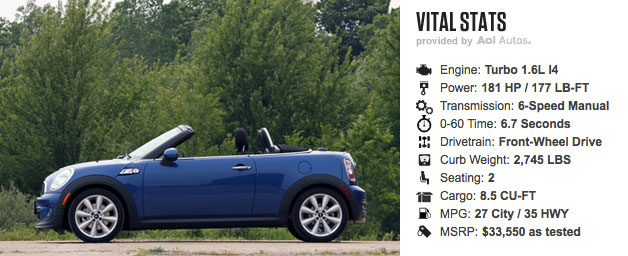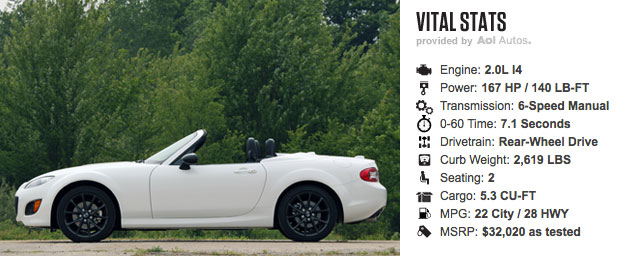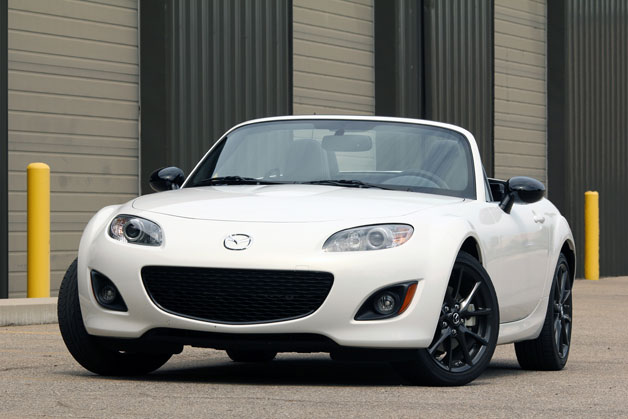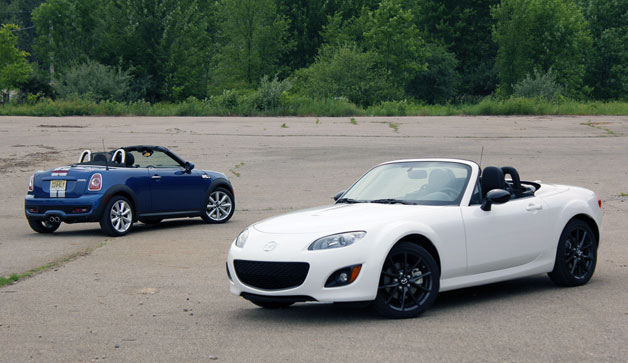We've been eying this fight for a long time. Since the reborn Mini first burst on the scene in 2002, really. Oh, the Mini Cooper Convertible has been around since 2005, but we just couldn't bring ourselves to compare them. What with all that physical and visual weight from the Mini's nearly useless rear seats, it just didn't seem like a fair fight. The classically proportioned rear-drive Mazda MX-5 Miata against a front-drive droptop with a pair of roll hoops awkwardly stationed behind the second row of seats, Tour de France-sized blind spots and a windshield header so far away from the driver as to be oddly distant – not to mention streetlight blocking? No, the Mini Convertible wasn't the answer we were looking for.Like an aging ballplayer, the Mazda is starting to look a little gray around the temples – a bit vulnerable.
And neither, as it turns out, have been all the other suitors the industry has concocted over the Miata's considerable lifespan. Everything from General Motors' Pontiac Solstice and Saturn Sky twins to the Aussie-built Mercury Capri, Toyota MR2 Spyder and Honda Del Sol has tried to crack Miata's iron grip on the affordable and fun basic roadster crown, and all have collapsed rather miserably. The Miata has been around for nearly a quarter century, and it's cornered the affordable convertible market for both new enthusiasts and golden oldies looking for a British sports car that doesn't leak and bears no trace of Lucas electrics. To borrow shamelessly from Terence Mann of Field Of Dreams (say it in your best James Earl Jones bellow):
But now, like an aging ballplayer, the Mazda is starting to look a little gray around the temples – a bit vulnerable. Despite a steady stream of small tweaks and tugs and a parade of special editions, this third-generation NC Miata has been on the market since 2005. Since that time, Mini has effectively released its second generation of ragtop Coopers with this new-for-2012 Mini Roadster, and it poses a more serious threat to the Miata than even we realized."The one constant through all the years, Ray, has been the Miata. America has rolled by like an army of steamrollers. The sports car market has been erased like a blackboard, rebuilt and erased again. But the Miata has marked the time."

It's amazing what a difference a convertible top can make. We've already gone on record saying we don't understand the new Mini Cooper Coupe in the least. From its contrived roofline to its less functional interior, deeply compromised visibility, heftier price tag and beefier curb weight, the Coupe undoes the lion's share of the Cooper hatchback's core charms. And yet, by swapping out the backwards ballcap for a folding soft top, this Roadster erases a multitude of sins and earns a second chance.
Compared to the Mini Convertible that will continue to be offered, the Roadster possesses better proportions, better visibility and in general, just comes across as a more organic and focused proposition. Even so, its high beltline combined with such short overhangs makes the Mini look a bit stubby from certain angles. Editor Steven Ewing: "My preference for the Miata stems from one core reason: Unlike the Mini, the MX-5 was designed to be a roadster from the get-go, whereas the porky Brit simply looks like the adorable Hardtop with its roof cut off."Its high beltline and short overhangs make the Mini look a bit stubby from certain angles.
For the purposes of this comparison, we sourced a mid-level 2012 Cooper S Roadster and a 2012 MX-5 Miata Special Edition PRHT (that's Power Retractable Hard Top in Mazda-ese). Given the myriad ways one can customize a Mini, our $33,550-as-delivered Cooper S seems like the orderer exercised due restraint, despite nearly $6,000 in options including a $1,500 Sport Package (gunmetal 17-inch alloys, Dynamic Traction Control, Xenon headlamps and... white turn signal lights?), $2,000 Technology pack (premium audio, park distance control and armrest), keyless go ($500) and a reasonable-sounding $750 for Mini Connected with Navigation.

That's a few peanuts more expensive than our $32,020 Mazda, whose Special Edition trim is as loaded as one can order (think: Grand Touring plus premium and suspension packages). Our one-of-450 Special Edition had no options but packed heated leather seats, automatic climate control, Bose audio, keyless start, Bluetooth telephony and Xenons. More importantly, the normally optional $650 sport suspension package underpinned our Crystal White tester, including Bilstein shock absorbers and a proper limited-slip differential.
Despite being loaded to the sills for a Miata, this Mazda's interior seems oddly stark compared to the Mini's retro-steeped cabin. Soft plastics are the exception, not the rule, and some of the switchgear and trim pieces feel cheap. Storage is notable by its absence. But on the other hand, everything is incredibly intuitive and ergonomic. The gauges are all dead ahead just as the sports car gods intended, and they are simple and easy-to-read, dominated by an oversized rev counter and a 150-mph speedometer. The stereo might look (and indeed sound) a bit aged, but it's got large knobs and buttons, and the three-dial HVAC setup below is no less intuitive.The Mazda's interior seems oddly stark compared to the Mini's retro-steeped cabin.
The leather-wrapped steering wheel is a three-spoke Goldilocks, not too thin and not too thick, confidence-inspiring with basic, unobtrusive redundant controls for audio and cruise, and the airbag boss is commendably small. We wouldn't mind the addition of a telescoping steering column, but all controls fall readily to hand and it proved easy for our average-height frames to find the sweet spot. Grumbles? We'd rather have the 12-volt accessory socket mounted somewhere else so that whatever is plugged into it doesn't interfere with shifting, and, as Ewing says, "Don't even think about using those cupholders."



Conversely, the Mini Roadster cabin – even in our tester's somber black – is a veritable theme park for the eyes, with bold door panels, clever surfboard-shaped pedals, and of course, a dinner-plate-sized center speedometer and Mini Connected infotainment readout. Individual elements are a delight, from the toggle switches to the half-moon door pulls to the puck-shaped key fob receptacle. There's a lot going on here. All materials, be they polymer or animal hide, are an obvious notch or two above the Miata, and the cabin is just plain larger.
In true Mini fashion, there are roughly a billion ways to personalize the furnishings, from various patterns for the dashboard to different colored leather for the steering wheel and e-brake, and there are over a dozen seat fabric and leather options. Hell, you can even get illuminated Union Jack doorsill plates or an electric cooler bag if that's your... um... bag. It's all enough to make the Miata's accommodations look like a $30/night European hotel from that summer in college – you know, without the funny smell.All materials are an obvious notch or two above the Miata, and the cabin is just plain larger.
In actual use, however, the Cooper's control experience is often more hostile than hostel. Just like every other modern Mini, this car's layout will have your eyes and hands fumbling around when looking for that desired button or bit of information on a readout. The top third of the tachometer is blocked by the chunky steering wheel no matter how you tilt it, the floating needle for the analog speedo is so small that you will soon use the Chicklet-sized digital mph readout on the tach instead, and the window and seat heater toggles are blocked when the cupholders are in use. What's more, the optional Mini Connected screen, which governs everything from the audio system to navigation and vehicle settings through a fiddly undersized nub next to the gear lever, can wash out in sunlight – something of a problem in a convertible. The functionality of the Mini's dashboard is, to be charitable, a mess. A high-fashion mess, perhaps, but still a multiple-car pileup for ergonomicists.



In a bit of a role reversal from what you might expect, the canvas soft top on our Mini is completely manual, while the Miata has power folding hardtop. But a word of explanation is necessary here – this Mini's manual top is a one-year deal. In June, parent company BMW announced specifications for the 2013 Roadster, and all models will arrive with a "semi-automatic roof" and wind deflector as standard equipment. On this 2012, however, lowering the top is easy, requiring just a simple pull down and twist on the center-mounted handle before pushing the top back over your shoulder. It can be difficult to consistently get the top to latch in the down position without unbuckling and getting out of the car, but with a bit of practice, it's possible to get it right. Putting the top up, however, will almost certainly require getting out of the car unless you are a skilled contortionist over six feet tall. The new-for-2013 "semi-automatic" roof still requires releasing the center header latch, but it's an easy enough operation.The canvas soft top on our Mini is completely manual, while the Miata has power folding hardtop.
Naturally, a manual soft top is also available on the Mazda and it saves both money (nearly $2,000) and about 80 pounds of weight, but the power hardtop is a simple one-button affair that doesn't sacrifice trunk space or the car's visuals. Incidentally, we've had plenty of experience with the Miata's manual folding top, and if that's the way you choose to go, it's much easier to operate in both directions than the Mini's manual roof, and doing so can be done more easily from the comfort of the driver's seat. Eighty pounds isn't a trivial matter, and the manual soft top seems to be more in-tune with the Miata's puritanical streak, but the hardtop quiets down the interior nicely, provides additional theft protection and looks slick, too (especially in contrasting black as on our Special Edition). Besides, we're guessing that most drivers wouldn't know they were toting around the extra weight outside of a track or a series of back-to-back runs.




These two cars might offer similar form factors, but sitting in them provides a completely different perspective. In the Miata, you adopt a more classic sports car posture – seating is lower to the floor, legs are out, and visibility is good, with low doorsills giving an expansive view. Like other Minis, the Roadster has a relatively high beltline, so even though you naturally take on a more upright seating position, you still feel like you are wearing a bigger car, and you can't settle in to the favored roadster "elbow on the sill" driving position as comfortably.These two cars might offer similar form factors, but sitting in them provides a completely different perspective.
With their tops erected, the Miata still manages to be easier to see out of. The Mini's side glass is quite shallow, its rear pillars are massive and the back window is small. Couple that with an active rear wing that rises up at 50 mph, and you have a recipe for compromised rearward visibility. Editor Ewing: "The Miata still gives you that fits-like-a-glove feeling. I much prefer the driving position, as well as the placement of the shifter, controls, etcetera. It just seems so much more driver-focused than the Mini." Editor-in-Chief John Neff agrees, but counters with a comment that cites comfort over clarity: "The Miata's interior may be better suited to the act of driving, but it feels more cramped. While a hot mess, the Mini's interior was more comfortable to be in for longer periods, and you eventually get used to its idiosyncrasies."

If the seating positions show two different approaches to elemental motoring, so too do their powertrains. Our front-drive Mini Cooper S Roadster's engine measures just 1.6 liters, but it's a thoroughly modern piece with direct injection and variable valve timing, and it's breathed on by a twin-scroll turbo. A glance at the spec page reveals 181 horsepower at 5,500 rpm and torque is listed at 177 pound-feet, coming in at a low 1,600 rpm. What's more, when you really need all the juice, the ECU will momentarily switch into overboost mode to dish up 192 lb-ft between 1,700 and 4,500 rpm for up to 10 seconds – ideal for passing power or for blasting down a circuit's straightaway. For those keeping track, the Cooper S is the middle child of the Roadster family – a normally aspirated 1.6-liter comes standard in the non-S model (good for 121 hp and 114 lb-ft), but if you've got the extra cash and the inclination, there's a John Cooper Works model that offers 208 hp and 192 lb-ft of torque (207 with overboost).If the seating positions show two different approaches to elemental motoring, so too do their powertrains.
By comparison, the Miata is simplicity itself. No forced induction, no direct injection, no sport programs, no artificial sweeteners and no preservatives, just a whole-grain, all-aluminum 2.0-liter four-cylinder with variable intake valve timing generating 167 hp at 7,000 rpm and 140 lb-ft at 5,000 rpm. It's the only engine offered, though if you're a milksop and go for the six-speed paddleshift automatic, you'll see power curbed to 158 horses and the redline cascade from 7,200 rpm all the way down to 5,700 revs. Serves you right.
Base Miatas (dubbed "Sport") make do with a perfectly nice five-speed manual, but uplevel Touring, Grand Touring and Special Edition models like ours get an extra cog, useful out on the highway. The Mini Roadster is served up with a standard six-speed manual, but an automatic is available with as many gears.


Before this summer's miserable Midwest heat wave settled in, we gathered these two up for some hard driving over Southeast Michigan's B-roads and even ran them around in the city of Detroit and on the open freeway for good measure.
By the numbers, these two canvasbacks are shockingly similar. We were expecting a bigger curb weight gulf, for one thing, but the two are surprisingly close, with the Miata ringing in at 2,619 pounds and the Cooper S at 2,745. Neither model is the lightest in their respective range, but the dolled-up Miata still weighs less than a base Cooper Roadster's 2,635 lbs. Thanks to the Mini's more authoritative engine, though, the Cooper enjoys a slightly better weight to power ratio.We were expecting a bigger curb weight gulf, but the Miata rings in at 2,619 pounds and the Cooper S at 2,745.
Mass being the enemy of dynamics, the Mini's comparative bulk also hurts it while pounding along the area's indifferently surfaced winding roads, but it paid dividends elsewhere. It didn't take long to establish a rhythm with the Miata – we could pile into corners effortlessly and hang the tail out playfully without alarming ourselves or passers-by. Its hydraulic steering is quite light, but weighs up appropriately in corners and is neither slow nor darty in its quickness. The front-drive Mini is somewhat harder to get a handle on, as its more upright seating position, heavier but less communicative electric power steering and notably stiffer suspension and sidewalls don't enable the same level of confidence over Michigan's less-than-perfect road surfaces, particularly mid-corner bumps. We'd like to try this again without the factory run-flats.

Given the Cooper's front-drive architecture, a comparative lack of communication is to be expected, but the chasm in actual performance isn't as large as one might guess. Whenever the road unfurls itself momentarily, the Mini's torque reserves help it repeatedly scarf up whatever asphalt appears between it and the Mazda in the twisty bits. On unfamiliar roads, the tabletop torque curve is a godsend, as it's tougher to recover momentum in a car with a narrower powerband like the Miata if you happen to get a corner wrong. Editor Ewing notes: "The Mini's better low-end punch allows you to hold gears for longer amounts of time, whereas you have to be careful about gear selection in the Miata to make sure to get the most of the available horsepower." The Mini's torque advantage isn't just felt on serpentine roads, either – it has plainly better passing power and feels more relaxed on the freeway, as well. That said, we enjoy revving out the MX-5 to its 7,200 rpm zenith far more than the Mini, whose redline is a comparatively pedestrian 6,500 rpm.Whenever the road unfurls, the Mini's torque reserves help it scarf up whatever asphalt appears between it and the Mazda in the twisty bits.
Braking capability is outwardly alike, as the two rely on similar systems (Mini: 11.6-inch vented fronts / 10.2-inch solid rears vs. 11.4-inch vented / 11.0-inch solid rears), but feel is solidly in the Mazda's camp as well, with a more easily metered pedal action. Given that one can rotate the MX-5 with throttle-on oversteer, there are fewer moments where one feels the need to rely on the leftmost pedal. Perhaps as a consequence, Ewing argues, "The Cooper's brakes feel like they are quicker to fade than the Mazda's. Though again, you're using them more in the Mini to properly set it up for cornering." The Miata's pedals are better oriented for fancy pedal work like left-foot braking, too, though the Mini's clutch is easier to get used to.




While we aren't big fans of the Mini's seating height, we find its chairs to be our preferred perches, both in corners and trundling along on the superslab. The Miata's seats simply don't have the same amount of bolstering and the Cooper's squabs seem better suited for long-distance comfort. In fact, just about everything is better suited for long distance driving in the Mini. Though the chassis thumps along over expansion joints (those damned runflats again), the Mini's longer wheelbase – 97.1 inches vs. 91.7 – helps it feel a little more at home on freeways than the Miata. That's particularly true with the top down, as even with its little plastic flip-up wind blocker in place, the Mazda's interior is a comparative niagara of air currents, making it tough to arrive without your hair looking like something out of a Flock of Seagulls tribute band. It's similarly harder to hold a conversation in normal voices or listen to its sadly tinny audio system.Both the Miata and Cooper make entertaining mechanical noises and their sound signatures are very, very different.
Of course, you'll want to forget the stereos altogether – both the Miata and Cooper make more entertaining mechanical noises and their sound signatures are very, very different. In the case of the Mazda, you get heaping helping of induction and exhaust feedback, particularly in the engine's upper reaches, an area you'll want to mine often for power anyhow. In standard mode, the Mini is significantly quieter and not terribly special. Thumb the Sport button, however, and the Mini's exhaust finds its fizz, popping and burbling on overrun gleefully. So entertaining is this party trick that we have frequently found ourselves adolescently goosing the throttle to "burp" our compatriots in the trailing Mazda. It's not quite on the level of Fiat 500 Abarth effervescence, but its dual-mode setting also means you don't have to wear your boy racer credentials all the time, either.

When the road straightens and becomes punctuated by the everyday drudgeries of stoplights, school zones and traffic jams, the Mini's modern powerplant reveals itself as being significantly friendlier at the pump, too. The EPA rates the Cooper S at 27 miles per gallon and the city and 35 mpg on the highway. Mazda's Skyactiv eco-performance calisthenics regime has yet to be baked-in to the Miata, and it turns in a disappointing 21/28. The Mini even has a slightly larger tank, 13.2 gallons to 12.7, and the trunk is much larger, too.
At the end of the day, the Mini is a very fine machine – one that's surprisingly entertaining while making for a less-compromised everyday driver. But for enthusiasts, it's not the winner of this showdown. Practicalities be damned, the Mazda is the one we want in our garages, whether driving amongst Iowa cornfields or Michigan city streets. It may be a bit larger and a bit heavier than its forbearers, but its purity – its tactility – is not to be denied. Paraphrasing Mann in Field Of Dreams again: "This car – this Miata – is a part of our past, Ray. It reminds us of all that once was good, and that could be again. Oh, people will come, Ray. People will most definitely come."
Yet again, the Miata goes the distance.










Sign in to post
Please sign in to leave a comment.
Continue